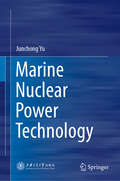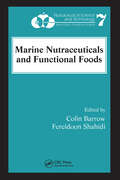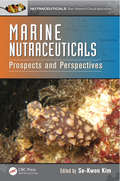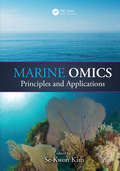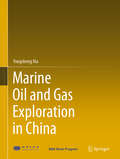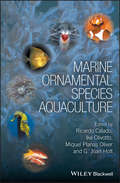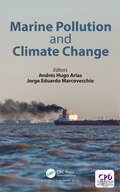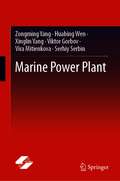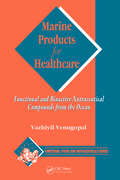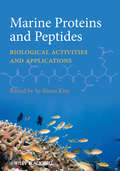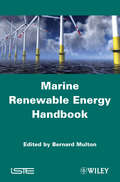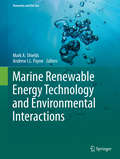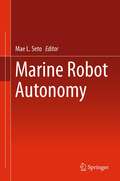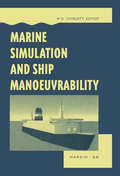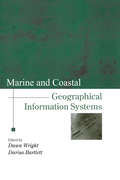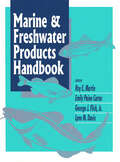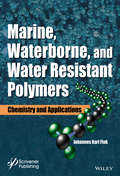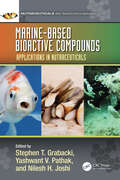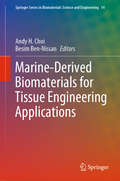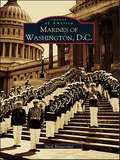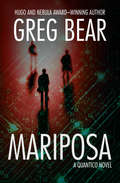- Table View
- List View
Marine Nuclear Power Technology
by Junchong YuThis book introduces readers to basic approaches in and principles of marine nuclear power design, including overall reactor design, in-core design, coolant systems and devices, I&C system design, safety system design, and dynamic analysis assessment. It comprehensively reviews both the fundamentals of and latest trends in nuclear-powered devices, covering their entire lifespan, from design and testing to operation and decommissioning. Further, it explores in detail various real-world conditions in the marine context – such as insufficient space for equipment deployment and frequently changing operating conditions as well as swinging and tilting. Offering extensive information on the design and operation of marine nuclear power systems, the book is a valuable resource for researchers and professionals in the area of marine science and nuclear engineering, and graduate students intending to embark on a career in the field.
Marine Nutraceuticals and Functional Foods (Nutraceutical Science and Technology)
by Colin Barrow Fereidoon ShahidiTwo of the most popular nutraceutical products on the market, omega-3 oil and glucosamine, were originally derived from waste products. Discarded oil from the manufacture of fishmeal became wildly popular as omega-3, a polyunsaturated fat, and the fully hydrolyzed chitosan from shrimp and crab shell, glucosamine, found wide use in joint health. Hun
Marine Nutraceuticals: Prospects and Perspectives (Nutraceuticals)
by Se-Kwon KimThere is a great deal of consumer interest in natural bioactive substances due to their health benefits. Offering the potential to provide valuable nutraceuticals and functional food ingredients, marine-derived compounds are an abundant source of nutritionally and pharmacologically active agents, with both chemical diversity and complexity. Functio
Marine OMICS: Principles and Applications
by Se-Kwon KimThis book provides comprehensive coverage on current trends in marine omics of various relevant topics such as genomics, lipidomics, proteomics, foodomics, transcriptomics, metabolomics, nutrigenomics, pharmacogenomics and toxicogenomics as related to and applied to marine biotechnology, molecular biology, marine biology, marine microbiology, environmental biotechnology, environmental science, aquaculture, pharmaceutical science and bioprocess engineering.
Marine Oil and Gas Exploration in China
by Yongsheng MaThis book systematically introduces the petroleum geological characteristics and exploration theory of marine strata in China. On the basis of four major basins, 14 typical cases have been studied in which 13 cases are from conventional oil and gas fields and 1 case is from shale gas field, along with their hydrocarbon generation, migration, accumulation, and distribution characteristics. The book provides a reference for geologists around the globe to understand the exploration history, methods and advances in marine strata oil and gas exploration in China.
Marine Organisms: Uses in Bioremediation and in Biorefinery (Environmental Challenges and Solutions)
by Telma Encarnação Alberto Canelas PaisMarine environments represent an underexplored source for numerous biotechnological applications. Of particular interest are organisms that can provide various valuable molecules and are potential candidates for bioremediation strategies. Fungi, algae, bacteria, yeasts, and sponges are some unique resources in marine ecosystems. But these must be preserved and protected from irreversible damage. Sustainable exploitation through farming systems is the alternative to prevent pressure on harvesting wild marine organisms. Written by an international team of experts, this book provides a broad overview of the possible approaches and technologies that can be applied in bioremediation processes and the possibilities to add value to the biomass produced. It provides a comprehensive state-of-the-art of current research and practice in bioremediation technology and bio-based materials. New processing technologies, and recent technical advances in molecular biology such as gene mining, omics techniques, and metabolic engineering are highlighted. The exciting possibilities that artificial intelligence can bring to the future of the biotechnology industry are also approached. The multidisciplinary nature of this book makes it of interest to a wide range of readers, including researchers, students, consulting professionals, engineers, governmental entities, and institutions working in environmental biotechnology, pollution control and prevention, and chemical processes.
Marine Ornamental Species Aquaculture
by G. Joan Holt Ike Olivotto Miquel Planas Oliver Ricardo CaladoThe global trade of aquatic organisms for home and public aquariums, along with associated equipment and accessories, has become a multi-billion dollar industry. Aquaculture of marine ornamental species, still in its infancy, is recognized as a viable alternative to wild collection as it can supplement or replace the supply of wild caught specimens and potentially help recover natural populations through restocking. This book collects into a single work the most up-to-date information currently available on the aquaculture of marine ornamental species. It includes the contributions of more than 50 leading scientists and experts on different topics relevant for the aquaculture of the most emblematic groups of organisms traded for reef aquariums. From clownfish, to angelfish, tangs and seahorses, as well as corals, anemones, shrimps, giant clams and several other reef organisms, all issues related with the husbandry, breeding, and trade are addressed, with explanatory schemes and illustrations being used to help in understanding the most complex topics addressed. Marine Ornamental Species Aquaculture is a key reference for scientists and academics in research institutes and universities, public and private aquaria, as well as for hobbyists. Entrepreneurs will also find this book an important resource, as the culture of marine ornamental species is analyzed from a business oriented perspective, highlighting the risks and opportunities of commercial scale aquaculture of marine ornamentals.
Marine Otter Conservation
by Liliana Ayala Raúl Sánchez-Scaglioni Gonzalo Medina-VogelThis book offers a multidisciplinary approach to conservation issues related to the marine otter (Lontra felina). The main goal is the systematization of different research efforts on this species, to contribute with conservation policy design and implementation. The authors contribute their achievements in conservation, ecology, status in freshwater habitats, habitat fragmentation effects, interaction with human activities and recommendations for an effective conservation of the species. The book is directed first and foremost towards researchers and authorities and people involved in conservation tasks of otters.Despite in the last decades some studies and efforts on Lontra felina has carried in Peru and Chile, some information can be gathered to fill the gaps on marine otter conservation in Peru. That is the main goal of the book Conservation of Marine Otter. Moreover, the publication will be the first book published at international level on Lontra felina with the participation of several experimented researchers on this threatened and endemic species.
Marine Plastics: Innovative Solutions to Tackling Waste
by Siv Marina Flø Grimstad Lisbeth Mølgaard Ottosen Neil A. JamesThis open access book reflects aims of the Blue Circular Economy (BCE) project, which focused on small and medium-sized enterprises (SMEs) aiming to create value using circular economy concepts related to products and services within fishing gear recycling in the Northern Periphery and Arctic (NPA) area. Cluster establishment and operation were carried out in collaboration with academia, industry and government agencies following a triple-helix approach. Discarded fishing gear constitutes a large part of marine plastics. Preventing future discharge of fishing gear into the ocean is a vital step in combating plastic pollution. Circular economy is one of the tools in the European Green deal, targeting waste minimisation. Closing the loop for waste fishing nets by transferring them to a resource could be a solution for preventing discharge at sea: exploring this opportunity is at the core of this book.
Marine Pollution and Climate Change
by Andres Hugo Arias Jorge Eduardo MarcovecchioThis book presents a broad overview of pollution issues facing climatic, economic, and legal globalization. Topics include changes in oceans from ancient times to the present, the importance of marine currents and changing climates, marine pollution linked to climate change (fossil fuels, global carbon dioxide, heavy metals, pesticides, plastics, emerging pollutants, and marine debris), global shipping and species invasion, global climate change in the Arctic and Antarctic environments, and regulatory responses to mitigate pollution and climate change in oceans.
Marine Polysaccharides: Food Applications
by Vazhiyil VenugopalIncreased public awareness of the importance of healthy living presents new challenges for the commercial food processing sector. The industry is always on the hunt for novel and safe additives with functional properties that can be used to impart healthy and appealing properties to foods. While the ocean is known as a conventional source of fish p
Marine Power Plant
by Zongming Yang Huabing Wen Xinglin Yang Viktor Gorbov Vira Mitienkova Serhiy SerbinThis book describes the history and development of marine power plant. Problems of arrangement, general construction and parameters of marine power plants of all types are considered. It also introduces different characteristics of each type of marine power plant, matching characteristic for diesel propulsion. The book gives a clear idea about different marine power engines, including working principle, structure and application. Readers will understand easily the power system for ships since there are a lot of illustrations and instructions for each of the equipment. This book is useful for students majoring in “marine engineering”, “energy and power engineering” and other related majors. It is also useful for operators of marine institution for learning main design and operation of ship plants.
Marine Products for Healthcare: Functional and Bioactive Nutraceutical Compounds from the Ocean (Functional Foods and Nutraceuticals)
by Vazhiyil VenugopalConsidered Mother Nature's medicine cabinet in many areas of the world, marine organisms have been known from time immemorial to possess curative powers. But until recently, their bioactive compounds, nutraceutical properties, and commercial potential remained undiscovered. Bringing together widely scattered literature, Marine Products for Healthca
Marine Proteins and Peptides: Biological Activities and Applications
by Se-Kwon KimFood proteins and bioactive peptides play a vital role in the growth and development of the body’s structural integrity and regulation, as well as having a variety of other functional properties. Land animal-derived food proteins such as collagen and gelatine carry risks of contamination (such as BSE). Marine-derived proteins, which can provide equivalents to collagen and gelatin without the associated risks, are becoming more popular among consumers because of their numerous health beneficial effects. Most marine-derived bioactive peptides are currently underutilized. While fish and shellfish are perhaps the most obvious sources of such proteins and peptides, there is also the potential for further development of proteins and peptides from sources like algae, sea cucumber and molluscs. Marine-derived proteins and peptides also have potential uses in novel products, with the possibility of wide commercialization in the food, beverage, pharmaceutical and cosmetic industries, as well as in other fields such as photography, textiles, leather, electronics, medicine and biotechnology. Marine Proteins and Peptides: Biological Activities and Applications presents an overview of the current status, future industrial perspectives and commercial trends of bioactive marine-derived proteins and peptides. Many of the industrial perspectives are drawn from the food industry, but the book also refers to the pharmaceutical and cosmetics industries. There have recently been significant advances in isolating functional ingredients from marine bio-resources and seafood by-products for use in these industries, but little has been published, creating a knowledge gap, particularly with regard to the isolation and purification processes. This book is the first to fill that gap. Marine Proteins and Peptides: Biological Activities and Applications is a valuable resource for researchers in marine biochemistry field as well as food industry managers interested in exploring novel techniques and knowledge on alternative food protein sources. It will become a standard reference book for researchers involved in developing marine bio-resources and seafood by-products for novel nutraceutical, cosmetics, and pharmaceutical applications. It will also appeal to managers and product developers in the food, pharmaceutical and cosmetics industries, particularly those looking to use marine-derived proteins and peptides as substitutes or replacements for unfashionable or outdated food components.
Marine Renewable Energy Handbook
by Bernard MultonMarine renewable energy is a significant resource for generating electricity, and if some conversion technologies have already reached a certain level of maturity, others are emerging. The originality of this multidisciplinary book is to offer a broad spectrum of knowledge from academic and industry experts of various origins. It deals with general aspects such as the specificities and constraints of the marine environment, the concepts of hydrodynamics and ocean engineering, as well as the industrial and economic sides necessary for the assembly of projects. It also discusses conversion technologies such as offshore wind, tidal power plants, tidal stream turbines, wave energy converters and ocean thermal energy plants. Finally, two chapters are devoted to power electronic conversion and power transmission cables.
Marine Renewable Energy Technology and Environmental Interactions
by Mark A. Shields Andrew I.L. PayneIt is now widely recognized that there is a need for long-term secure and suitable sustainable forms of energy. Renewable energy from the marine environment, in particular renewable energy from tidal currents, wave and wind, can help achieve a sustainable energy future. Our understanding of environmental impacts and suitable mitigation methods associated with extracting renewable energy from the marine environment is improving all the time and it is essential that we be able to distinguish between natural and anthropocentric drivers and impacts. An overview of current understanding of the environmental implications of marine renewable energy technology is provided.
Marine Robot Autonomy
by Mae L. SetoAutonomy for Marine Robots provides a timely and insightful overview of intelligent autonomy in marine robots. A brief history of this emerging field is provided, along with a discussion of the challenges unique to the underwater environment and their impact on the level of intelligent autonomy required. Topics covered at length examine advanced frameworks, path-planning, fault tolerance, machine learning, and cooperation as relevant to marine robots that need intelligent autonomy.
Marine Simulation and Ship Manoeuvrability: Proceedings of the international conference, MARSIM '96, Copenhagen, Denmark, 9-13 September 1996
by M. S. ChislettReal-time, interactive ship simulators limped onto the scene, in the wake of flight simulators, some years ago. The maritime industries have a long history of conservatism, but this is now changing rapidly. The information age has also swept over ships and shipping, and has been taken to heart to such an extent that, for example, flight simulators now cooperate with ship simulators and import useful new concepts and methodologies. The more than 50 papers contained in this book show what and why. Although traditionally conservative, the marine world is also traditionally international and this has not changed. The papers in the book are by leading authors from all over the world and provide a detailed snap-shot of the rapidly advancing state-of-the-art, together with pointers to the future. The overall theme of MARSIM '96 and therefore also of this book is: Vessel manouevrability and marine simulation research, training and assessment, and includes original papers on topics such as bridge resource management, distant learning and simulators coupled via The Internet, virtual reality, neural networks, rudder-propeller hydrodynamics, prime mover models, squat in shallow water, and many more.
Marine and Coastal Geographical Information Systems (Research Monographs In Gis Ser.)
by Dawn J. Wright Darius J. BartlettMarine and coastal applications of GIS are finally gaining wide acceptance in scientific as well as GIS communities, and cover the fields of deep sea geology, chemistry and biology, and coastal geology, biology, engineering and resource management. Comprising rigorous contributions from a group of leading scholars in marine and coastal GIS, this book will inspire and stimulate continued research in this important new application domain.Launched as a project to mark the UN International Year of the Ocean (1998) and supported by the International Geographical Union's Commission on Coastal Systems, this book covers progress and research in the marine and coastal realms, in the areas of theory, applications and empirical results. It is the first book of its kind to address basic and applied scientific problems in deep sea and coastal science using GIS and remote sensing technologies. It is designed for GIS and remote sensing specialists, but also for those with an interest in oceans, lakes and shores. Coverage ranges from seafloor spreading centres to Exclusive Economic Zones to microscale coastal habitats; and techniques include submersibles, computer modelling, image display, 3-D temporal data visualization, and development and application of new algorithms and spatial data structures. It illustrates the broad usage of GIS, image processing, and computer modelling in deep sea and coastal environments, and also addresses important institutional issues arising out of the use of these technologies.
Marine and Freshwater Products Handbook
by Roy E. Martin George J. Flick Jr. Emily Paine Carter Lynn M. DavisComprehensive handbook of seafood information!This definitive reference is the most comprehensive handbook of information ever assembled on foods and other products from fresh and marine waters. Marine and Freshwater Products Handbook covers the acquisition, handling, biology, and the science and technology of the preservation and processing of
Marine, Waterborne, and Water-Resistant Polymers: Chemistry and Applications
by Johannes Karl FinkThis book focuses on the chemistry of marine polymers, waterborne polymers, and water-resistant polymers, as well as the special applications of these materials. After the chemistry of marine polymers and their types are discussed, the uses of these polymers are detailed, as well as various analytical and characterization testing methods. The book also emphasizes the polymers that are most environmentally-friendly along with their origin and industrial applications. The polymers from these 3 types serve a variety of industries including medical equipment and devices, outdoor coatings and corrosion protection, food packaging, saltwater and freshwater marine purposes, paper, and marine well application, to name just a few.
Marine-Based Bioactive Compounds: Applications in Nutraceuticals (Nutraceuticals)
by Yashwant V. Pathak Nilesh H. Joshi Stephen T. GrabackiThe ocean offers boundless benefits to human health. Known for millennia as a source of food, it is continuously gaining recognition as a provider for a variety of materials, and as the largest habitat on our planet, the ocean’s biodiversity stands far above anywhere else. Functional ingredients derived from marine algae, invertebrates, and vertebrates can help fill the need for novel bioactives to treat chronic conditions such as cancer, microbial infections, and inflammatory processes. The latest addition to the Nutraceuticals: Basic Research/Clinical Applications series, Marine-Based Bioactive Compounds: Applications in Nutraceuticals provides an account of marine-derived nutraceuticals and their potential health benefits. Key Features: Provides the latest information on trends in this fast-growing market Focuses on the six marine taxa that offer the most exciting potential Gives practical guidance to anyone wishing to enter this sector With contributions from an international group of experts, this book presents a great many opportunities in marine nutraceuticals from the six oceanic taxa that offer the most potential to benefit human health. It is a great resource for established nutraceutical companies.
Marine-Derived Biomaterials for Tissue Engineering Applications (Springer Series in Biomaterials Science and Engineering #14)
by Besim Ben-Nissan Andy H. ChoiThis book presents the latest advances in marine structures and related biomaterials for applications in both soft- and hard-tissue engineering, as well as controlled drug delivery. It explores marine structures consisting of materials with a wide variety of characteristics that warrant their use as biomaterials. It also underlines the importance of exploiting natural marine resources for the sustainable development of novel biomaterials and discusses the resulting environmental and economic benefits. The book is divided into three major sections: the first covers the clinical application of marine biomaterials for drug delivery in tissue engineering, while the other two examine the clinical significance of marine structures in soft- and hard-tissue engineering, respectively. Focusing on clinically oriented applications, it is a valuable resource for dentists, oral and maxillofacial surgeons, orthopedic surgeons, and students and researchers in the field of tissue engineering.
Marines of Washington D.C. (Images of America)
by Mark BlumenthalMarines of Washington, D.C. takes the reader on a visual tour that explores the dynamic history of the United States Marine Corps in the nation's capital. The Marines have played an integral role in the development of the social, structural, and political landscape of Washington for over 200 years. This volume traces the history of the Marines from the founding of the "Oldest Post of the Corps," Marine Barracks Washington in 1801, to participation in the War of 1812, the Civil War, the World Wars, and into the modern day. Explore the lasting impact of famous Marines, including Commandant Archibald Henderson, Marine Band Director John Phillip Sousa, and Commandants Alfred M. Grey and John A. Lejeune. Marines of Washington, D.C. highlights the unique relationship between the Marines of the nation's capital, the President, and the citizens of the United States they serve.
Mariposa (Quantico #2)
by Greg BearThe world just keeps getting tougher and more complicated. America teeters on the edge of bankruptcy because of crushing foreign debt and an apparent savior, The Talos Corporation, delivers training for soldiers and security forces around the world, logistical support and badly-needed troops economically, but with a hidden cost that&’s both sinister and disturbing.The three rookie FBI agents who survived the challenges portrayed in Quantico, have gone their separate ways but seem fated to be drawn back together in an alliance against a surprising challenge for which no one seems prepared. Rebecca Rose is brought back from an extended sabbatical when the President is shot and her second-in-command is implicated in an horrific crime—and all the threads point deeper into Talos&’s secretive activities. Fouad Al-Husam, working undercover inside Talos, has uncovered and been forced to hide vital information of a takeover plot that threatens America&’s independence.Nathan Trace, victim of a violent incident in the Middle East, struggles with post-traumatic stress and seems to be recovering through participation in a treatment program, code-named Mariposa, which has unexpected side-effects that turn patients into brilliant, detached and sociopathic individuals—very smart and extremely deadly.Only a desperate combination of misfits and survivors can combat an apparently inevitable collapse of American organization that will lead to the fall of democracy.
